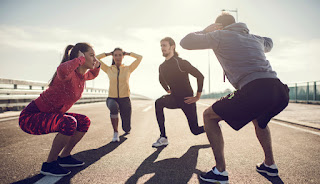What Your Squat Says About You
Like personality types, there are many different variations of squat form — and many prove what not to do when performing a squat. The good news is, how you perform a squat, especially if you’re not doing it right, can clue you into specific muscular imbalances, which you can then correct, leading to a stronger you. Below, three common squat-form mistakes and what they can tell you about where you need to build strength and flexibility.
If you lean forward …
It’s common to have a tendency to lean forward when trying to squat deeper, but a forward-leaning squat could indicate weak glutes and/or tight hip flexors. When the glutes aren’t strong enough, the hip flexors take over to pull you deeper into the squat, causing you to lean forward. If the forward lean is a result of tight hip flexors, the quadriceps take over and shift the center of gravity, bringing you forward.
The way to correct a forward-leaning squat is severalfold. First, strengthen the posterior muscles and be sure to tighten the upper back when squatting. If the upper back isn’t strong enough to support the squat, form will suffer. A lack of flexion in the hips is usually due to sitting for long periods of time. Be mindful about how much you sit and incorporate hip mobility exercises. Finally, make sure your glutes and hamstrings are strong enough by warming them up for squats properly with movements like glute bridges and fire hydrants.
If your heels come off the ground …
Lifting the heels off the ground is another common squatting mistake, which can severely damage the knees. The primary cause of the heels lifting off the ground in a squat is due to poor ankle mobility, or tight calves, along with a general lack of squat form.
If ankle flexibility is a problem, try ankle and calf stretches to improve mobility, and stick with quarter squats (only squatting a quarter of the way) until you become flexible enough for parallel squats. To train form, try this: Perform wall squats facing a wall, with your toes touching the wall, and avoiding touching the wall with the knees or head when you lower down.
If your knees roll inward …
Common with beginner squatters and seasoned lifters alike, many people experience the knees rolling inward most often at the bottom of the squat, at the point where it reverses direction. According to the Journal of Strength and Conditioning, the knees rolling inward is an indication of weak glutes, tight hip adductors and calves, and potentially tight hip flexors.
To counteract the knees rolling inward, stretch and foam roll the inner thigh, calves and Achilles, and focus on strengthening the glutes.
Improving your squat takes time, and it’s important to remember that the answer to improving your squat form is not to add more weight. By adding more weight to faulty squat form, you’re setting yourself up for further imbalance and potential serious injury. Keep in mind that the body is a system and recognize how habits and positioning can clue you into where you may need to put more focus on correcting form and imbalance, regardless of what movements you’re doing.
Original article written by Brian Maher on Be Well Philly

Comments
Post a Comment